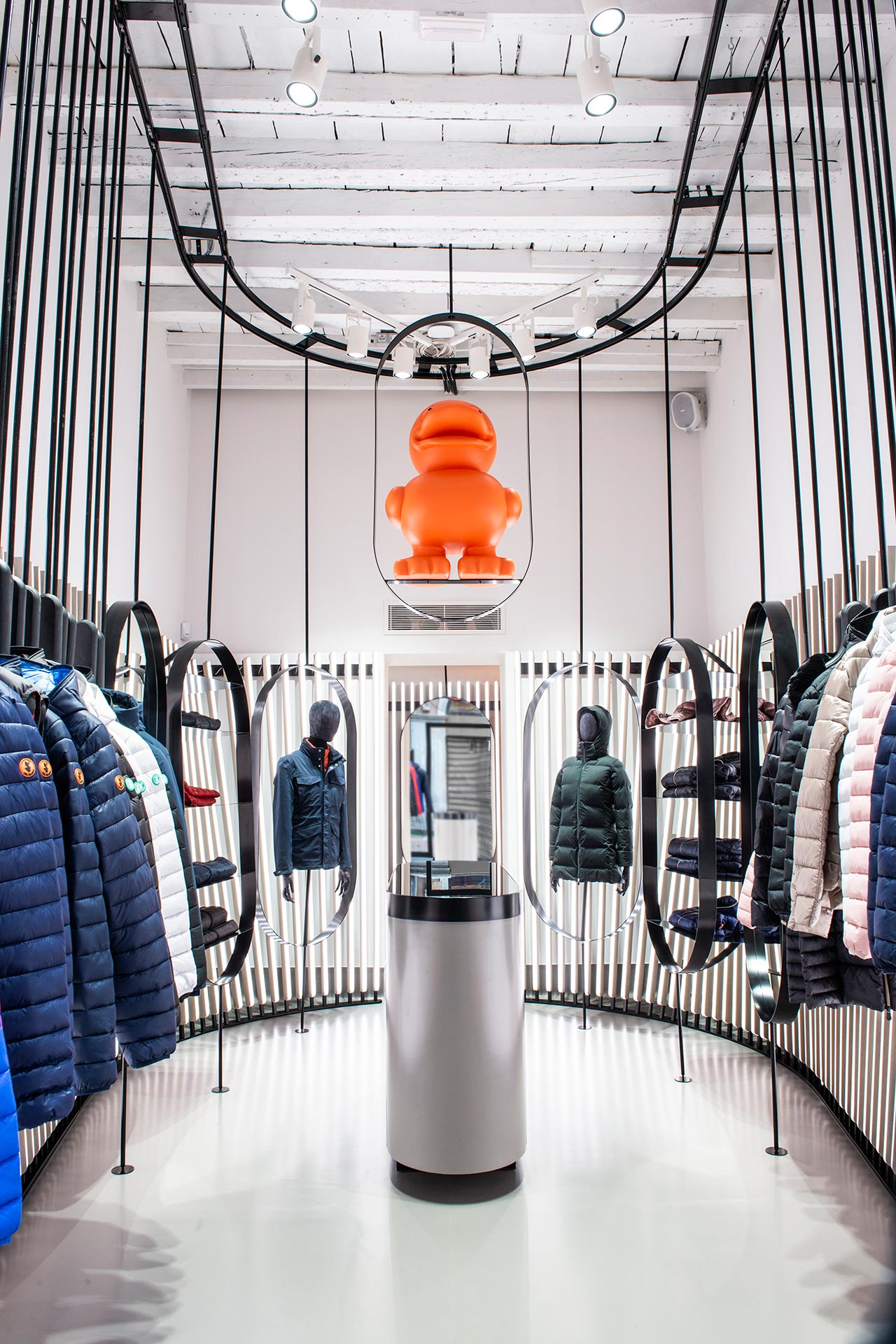



#165 FLAGSHIP STORE
2018
Save the Duck
with Futerra, UCL and DCMLab
Retail design and branding strategy
MAY THE DUCK BE WITH YOU
Marcel Mauer harnesses the power of brand narrative and story telling for Save The Duck’s first shopfront store in Milan Brera District.
On September 2018 ethical fashion brand Save The Duck celebrated the opening of their first branded shop in Milan. The design is by Marcel Mauer Architecture, UK design firm founded in East London with offices in Paris and Reggio Emilia, Italy. The site was delivered at record speed in two and half months after Marcel Mauer won a two stage international design competition. The winning entry stood out from the ten strong list of participants due to its engaging narrative built upon the Save The Duck core values, namely no harm to animals and decremental environmental impact .
“In our narrative the brand became a movement, the jacket a super-suit, the sale assistant an ambassador and the customer a secret agent. Willingly suspending their disbelief, the client realised that the fashion shop had become an ethical fashion secret base hidden in plain sight along the streets of Milan.”
Marcel Mauer’s pitch developed in partnership with Sustainability Strategy Consultant FUTERRA mixed unexpected and innovative media ranging from a radio show – little short of an episode of Hitchhiker’s Guide to the Galaxy – for the first stage and A0 format comics book for stage 2. In the words of Marcel Mauer co-director and founder Antonio Pisano : “we immediately felt that the brand had something unique. A strong ethical ethos that resounded immediately with our deep passion for social value and climate justice. In our narrative the brand became a movement, the jacket a super-suit, the sale assistant an ambassador and the customer a secret agent. Within our narrative framework suddenly the fashion shop had become a secret base hidden in plain sight along the streets of Milan. The choice to create a radio play and a comics book, stepping away from the comfort zone of usual architectural language, allowed us to maximise the power the jury’s own imagination”. Drawing from a complex web of inspirations ranging from GuyDebord to Tino Seghal, the concept was summarised in three easily recognisable design features:
- The Ribbon of Light, a ruled double curved surface defined my bespoke light fittings, which disrupts the perception of the walls’ constraints whilst focusing light and attention onto the products;
- The Idol, a 1.5 m tall sculpture of the brand’s duck logo, placed in the centre of the space at 2.26m height which sparks customer enquiry and provides the brand ambassador ample opportunity to expound on the values and history of Save the Duck and to stimulate an emotional connection with the brand;
- The path, which is a choreographed movement around the idol, reminiscent of a ritual circumambulation, during which the sale assistant presents brand values as well as products and engages with customers on topics such as latest fashion, animal rights and climate change.
Ed Gillespie, founder of FUTERRA, described Marcel Mauer pitch as “one of the most brilliant bonkers pitches I have ever been involved with”. After the victory, the architects had to move swiftly from narratives to construction details in order to meet the challenging programme. ECOR, a circular economy certified material developed in The Netherlands and explored by Marcel Mauer in collaboration with UCL, proved a great finishing panel to create the ribbon of light, a LED powered ruled surface, whilst a mix of steel and timber components were used to manufacture the rest of the retail scenography. With works started at the end of July under the site management of DCMLab, site was handed over to the client on the 1st of September and the shop officially opened a couple of weeks later. Milan fashion and design tribes gathered around the shop in Via Solferino under the bright orange logo shining on the full height glazed facade. Lorenzo Baldini, co-founder of Marcel Mauer, describes the opening event as “a humbling moment when our design concept, which started as a theoretical narrative machine, had unequivocally become reality. From this first shop we will move on swiftly and enthusiastically onto the definition of the brand’s design guidelines and approved details ready for the two years rollout of more stores in Europe, US and Asia.”

